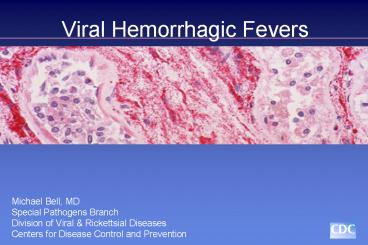Viral Hemorrhagic Fevers - PowerPoint PPT Presentation
1 / 28
Title:
Viral Hemorrhagic Fevers
Description:
... Viruses Bunyaviruses CRIMEAN CONGO HEMORRHAGIC FEVER (CCHF) Distribution of CCHF virus CCHF: Clinical features Slide 9 PREVENTION OF CCHF Slide 11 CCHF: ... – PowerPoint PPT presentation
Number of Views:183
Avg rating:3.0/5.0
Title: Viral Hemorrhagic Fevers
1
Viral Hemorrhagic Fevers
- Michael Bell, MD
- Special Pathogens Branch
- Division of Viral Rickettsial Diseases
- Centers for Disease Control and Prevention
2
VHF
- Acute infection
- fever, myalgia, malaise progression to
prostration - Small vessel involvement
- increased permeability, cellular damage
- Multisystem compromise (varies with pathogen)
- Hemorrhage may be small in volume
- (indicates small vessel involvement,
thrombocytopenia) - Poor prognosis associated with
- shock, encephalopathy, extensive hemorrhage
3
Viral Hemorrhagic Fever viruses
- Filoviruses Ebola Hemorrhagic fever (EHF)
- Marburg virus
- Arenaviruses Lassa fever
- New World Arenaviruses
- Bunyaviruses Rift Valley fever (RVF)
- Crimean Congo Hemorrhagic fever (CCHF)
4
VHF Viruses
- Encapsulated, single stranded RNA viruses
- Similar syndromes different pathogenesis
treatment - Persistent in nature rodents, bats, mosquitoes
- Geographically restricted by host
- Potential infectious hazards from laboratory
aerosols
5
Bunyaviruses
- Crimean Congo hemorrhagic fever
6
CRIMEAN CONGO HEMORRHAGIC FEVER(CCHF)
- Extensive geographic distribution
- (Africa, Balkans, and western Asia)
- Transmission
- Tick-borne (Hyalomma spp.)
- Contact with animal blood or products
- Person-to-person transmission
- by contact with infectious body fluids
- Laboratory worker transmission documented
- Mortality 15-40
- Therapy Ribavirin
7
Distribution of CCHF virus
8
CCHF Clinical features
- 4-12 day incubation after tick exposure
- 2-7day incubation after direct contact with
infected fluids - Abrupt onset fever, chills, myalgia, severe
headache - Malaise, GI symptoms, anorexia
- Leukopenia, thrombocytopenia, hemoconcentration,
proteinuria, elevated AST - Hemorrhages may be profuse (hematomas,
ecchymoses)
9
(No Transcript)
10
PREVENTION OF CCHF
- DEET repellents for skin
- Permethrin repellents for clothing
- (0.5 permethrin should be applied to clothing
ONLY) - Check for and remove ticks at least twice daily.
- If a tick attaches, do not injure or rupture the
tick. - Remove ticks by grasping mouthparts at the skin
surface using forceps and apply steady traction.
11
(No Transcript)
12
CCHF Pathogenesis
- Viremia present throughout disease
- IFA becomes positive in patients destined to
survive days 4-6, often simultaneously with
viremia - Recovery may be due to CMI or neutralizing
antibodies - Patients that die usually still viremic
- Virus grows in macrophages and other cells
- DIC often present
- Poor prognosis signaled by early elevated AST and
clotting
13
CCHF Slaughterhouses
- Sheep and cattle become viremic without disease
- Blood and fresh tissues infective by contact
- Possibility of establishing transmission of CCHF
in holding pens by Hyalomma or other tick vectors
14
Ribavirin
- Guanosine nucleoside analog
- blocks viral replication by inhibiting IMP
dehydrogenase - Licensed for treatment of RSV and HCV
- Potential adverse effects
- Dose dependent reversible anemia
- Pancreatitis
- Teratogen in rodents
15
Ribavirin indications
- Filoviruses No
- Rift Valley No
- CCHF Yes
- Lassa Yes
- Argentine HF Yes
- Other New world Arena Maybe
16
Ribavirin toxicities
- Teratogenic
- Extravascular hemolysis
- Bone marrow suppression
- Rigors with abrupt iv administration
- Reversible hyperbilirubinemia, hyperuricemia with
oral administration - Pruritus, nausea, depression, cough
17
Infection Control
18
Laboratory safety BSL-4
- In contrast to patient-care,
- high-level protection required for
- Laboratory manipulation
- Mechanical generation of aerosols
- Concentrated infectious material
- Viral culture
19
VHF Human-to-Human transmission
- None Yellow fever, Dengue, Rift Valley fever,
Kyasanur, Omsk (arboviruses), hantaviruses - Low Lassa and South American Arenaviruses
- High Ebola, Marburg, Crimean-Congo HF
20
History of Infection Control Precautions
- 1877 Separate facilities for infectious diseases
- 1910 Antisepsis and disinfection
- 1950-60 Closure of Infectious disease and TB
hospitals - 1970 CDCIsolation Techniques for use in
Hospitals - (7 categories, over-isolation)
21
History of Infection Control Precautions
- 1983 CDC Guideline Isolation Precautions in
Hospitals - (Disease-specific category-based including
blood and body-fluids) - 1985 Universal precautions
- 1987 Body substance isolation
22
History of Infection Control Precautions
- 1996 CDC/HICPAC revised guidelines
Standard Precautions
23
Standard Precautions
- Constant use of gloves and handwashing
- (plus face-shields, masks or gowns if splashes
are anticipated) for any contact with blood,
moist body substances, mucous membranes or
non-intact skin.
24
Standard Precautions
- Constant use of gloves and handwashing
- (plus face-shields, masks or gowns if splashes
are anticipated) for any contact with blood,
moist body substances, mucous membranes or
non-intact skin. - Additional, Transmission-based Precautions
25
Standard Precautions
- Transmission-based Precautions
- Airborne (TB, Chicken pox, Measles, Smallpox)
- Droplet (Diphtheria, Pertussis, Meningococcus,
Influenza, Mumps....) - Contact (Enteric infections, Respiratory
infections, Skin infections, Conjunctivitis. )
26
VHF Contact management
- Casual contacts e.g., shared airplane or hotel,
- No surveillance indicated
- Close contacts Direct contact with patient
and/or body fluids during symptomatic illness. - Fever watch during incubation period
- High risk contacts Needle stick, mucosal
exposure to body fluids, sexual contact. - Fever watch, consider inpatient observation.
27
www.cdc.gov/ncidod/hip/isolat/isolat.htm
- Complete text of the current CDC/HICPAC Isolation
Precautions are available on-line.
28
www.cdc.gov/ncidod/dvrd/spb/index.htmwww.cdc.gov
viral hemorrhagic fevers






























